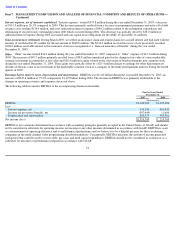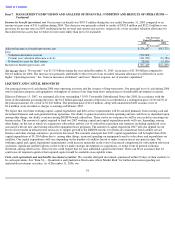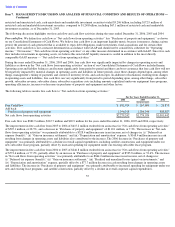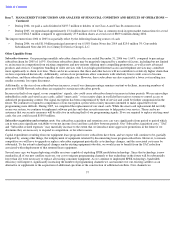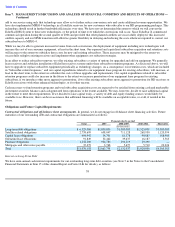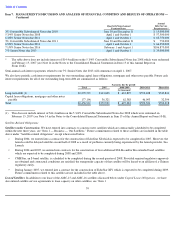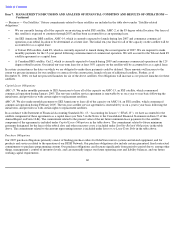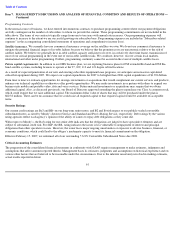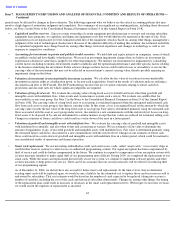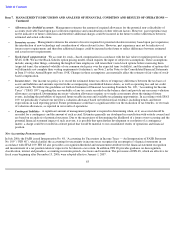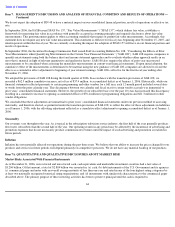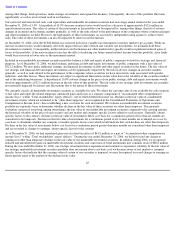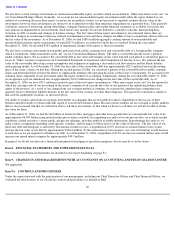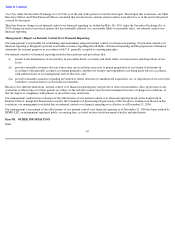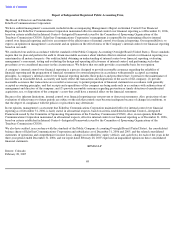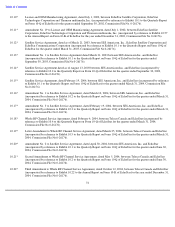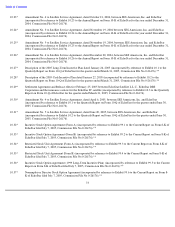Dish Network 2007 Annual Report Download - page 71
Download and view the complete annual report
Please find page 71 of the 2007 Dish Network annual report below. You can navigate through the pages in the report by either clicking on the pages listed below, or by using the keyword search tool below to find specific information within the annual report.
Table of Contents
New Accounting Pronouncements
In July 2006, the FASB issued Interpretation No. 48, “Accounting for Uncertainty in Income Taxes — An Interpretation of FASB Statement
No. 109
” (“FIN 48”), which clarifies the accounting for uncertainty in income taxes recognized in an enterprise’s financial statements in
accordance with SFAS 109. FIN 48 also prescribes a recognition threshold and measurement attribute for the financial statement recognition
and measurement of a tax position taken or expected to be taken in a tax return. In addition, FIN 48 provides guidance on derecognition,
classification, interest and penalties, accounting in interim periods, disclosure and transition. The provisions of FIN 48, which are effective for
fiscal years beginning after December 15, 2006, were adopted effective January 1, 2007.
63
Item 7.
MANAGEMENT’S DISCUSSION AND ANALYSIS OF FINANCIAL CONDITION AND RESULTS OF OPERATIONS —
Continued
•
Allowance for doubtful accounts
. Management estimates the amount of required allowances for the potential non-collectibility of
accounts receivable based upon past collection experience and consideration of other relevant factors. However, past experience may
not be indicative of future collections and therefore additional charges could be incurred in the future to reflect differences between
estimated and actual collections.
•
Inventory reserve
. Management estimates the amount of reserve required for potential obsolete inventory based upon past experience,
the introduction of new technology and consideration of other relevant factors. However, past experience may not be indicative of
future reserve requirements and therefore additional charges could be incurred in the future to reflect differences between estimated
and actual reserve requirements.
•
Stock
-based compensation . We account for stock—based compensation in accordance with the fair value recognition provisions of
SFAS 123R. We use the Black-Scholes option pricing model, which requires the input of subjective assumptions. These assumptions
include, among other things, estimating the length of time employees will retain their vested stock options before exercising them
(expected term); the estimated volatility of our common stock price over the expected term (volatility), and the number of options that
will ultimately not complete their vesting requirements (forfeitures), see Note 2 in the Notes to the Consolidated Financial Statements
in Item 15 of this Annual Report on Form 10-K. Changes in these assumptions can materially affect the estimate of fair value of stock-
based compensation.
•
Income taxes
. Our income tax policy is to record the estimated future tax effects of temporary differences between the tax bases of
assets and liabilities and amounts reported in the accompanying consolidated balance sheets, as well as operating loss and tax credit
carryforwards. We follow the guidelines set forth in Statement of Financial Accounting Standards No. 109, “Accounting for Income
Taxes” (“SFAS 109”) regarding the recoverability of any tax assets recorded on the balance sheet and provide any necessary valuation
allowances as required. Determining necessary valuation allowances requires us to make assessments about the timing of future
events, including the probability of expected future taxable income and available tax planning opportunities. In accordance with SFAS
109, we periodically evaluate our need for a valuation allowance based on both historical evidence, including trends, and future
expectations in each reporting period. Future performance could have a significant effect on the realization of tax benefits, or reversals
of valuation allowances, as reported in our results of operations.
• Contingent liabilities . A significant amount of management judgment is required in determining when, or if, an accrual should be
recorded for a contingency and the amount of such accrual. Estimates generally are developed in consultation with outside counsel and
are based on an analysis of potential outcomes. Due to the uncertainty of determining the likelihood of a future event occurring and the
potential financial statement impact of such an event, it is possible that upon further development or resolution of a contingency
matter, a charge could be recorded in a future period that would be material to our consolidated results of operations and financial
position.


